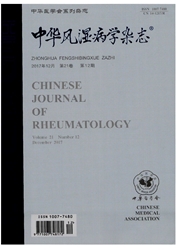

 中文摘要:
中文摘要:
目的研究成人斯蒂尔病(AOSD)患者血清及外周血细胞内巨噬细胞游走抑制因子(MIF).分析MIF与AOSD疾病病情活动的相关性,并初步探讨其在疾病中的发病机制。方法采用酶联免疫吸附法检测了20名健康对照、57例AOSD患者及其中13例随访患者血清中MIF水平,并采用三色法流式细胞术比较5例AOSD患者及6名健康对照外周血细胞内MIF含量。结果AOSD患者血清中MIF的水平为(204±228)ng/ml,较健康对照(27±19)ng/ml显著增高(P〈0.01)。血清MIF水平在具有咽痛、肌痛、脾大或浆膜炎表现的患者中显著增高(P〈0.05),并与病情严重程度(系统评分)显著相关(P〈0.01)。在对13例患者随访后发现血清中MIF水平与疾病活动性显著相关(P=0.003)。AOSD患者外周血单核细胞、T细胞中MIF水平显著高于健康对照(P〈0.05),而B细胞及粒细胞中MIF水平与健康对照差异无统计学意义(P〉0.05)。结论MIF为AOSD良好的疾病病情严重程度及活动性的监测指标,并可能在致病机制中发挥着重要作用。
 英文摘要:
英文摘要:
Objective To test the macrophage migration inhibitory factor (MIF) levels in serum and peripheral blood cells of patients with adult-onset Still's disease (AOSD), and analyze its relationship with disease activity. In addition, the role of MIF in the pathogenesis of AOSD is explored. Methods Serum MIF concentrations were detected by enzyme-linked immunosorbent assay (ELISA), and intracellular MIF production by peripheral blood cells were detected by three-color permeabilization flow cytometry. Results Serum MIF levels were significantly higher in AOSD (204±228) ng/ml than those in healthy controls (27±19) ng/ml, P〈0.01. MIF levels in patients with sore throat, myalgia, splenomegaly or pleuritis were higher than those without (P〈0.05). Furthermore, serum MIF levels were correlated with disease severity (P〈O.O1) and activity (P=0.003). In addition, intracellular MIF production in monocytes, T cells were significantly increased in patients with AOSD than in healthy controls, but no significant difference was observed in B cells and granulocytes. Conclusion MIF levels may be used as a favorable marker for disease severity evaluation and monitoring, and possibly play an important role in the pathogenesis of AOSD.
 同期刊论文项目
同期刊论文项目
 同项目期刊论文
同项目期刊论文
 期刊信息
期刊信息
